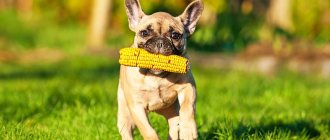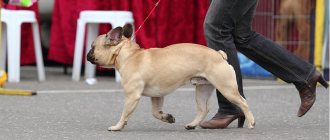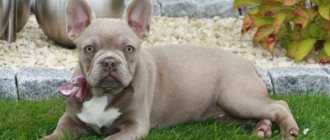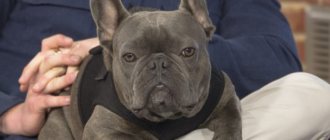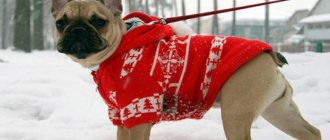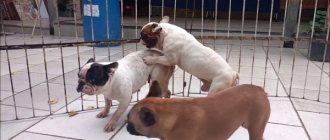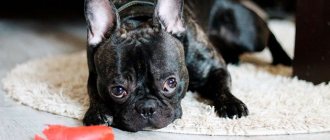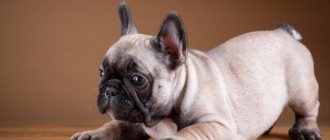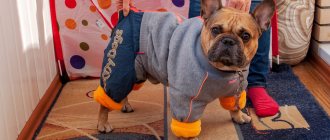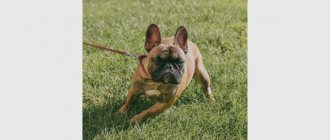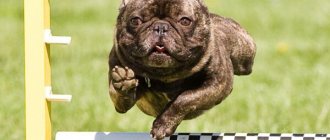The French bulldog, with its cute and attractive appearance, quickly won the hearts of dog lovers. But although caring for them is not as difficult as, for example, long-haired dog breeds, you still need to be on alert.
The maintenance of these small and stocky animals has its own nuances; they require constant love and care. Particular attention should be paid to the ears, which among owners are called “bat ears.”
How to clean a French bulldog's ears
Due to the characteristic structure of the dog’s hearing organs, dirt and sulfur accumulate in them, which provokes various inflammatory processes.
You should clean your pet's ears at least twice a month. At home, the hygienic procedure is carried out using cotton swabs or swabs wrapped around a finger and moistened with special lotions. If the owners take their French bulldog out of town in the summer, the pet’s ears should be the subject of the closest attention. When the dog
- constantly shakes his head and scratches his ears, sometimes until it bleeds,
- dark serous and then purulent discharge and a foul odor appeared in the ear canal
These are possible signs of infection with a mite that causes otodectosis - ear scabies. Parasitic infection is easily treated with modern medications, but you must contact your veterinarian in time to avoid complications. In pet stores you can also find preventatives against tick-borne infestations, but they, like other antiparasitic drugs, should not be abused.
What to do if your dog constantly scratches his ear?
Dogs can scratch their ears for numerous reasons, which only a veterinarian can accurately determine. Most often this is an allergic reaction or the result of mites. In any case, you should immediately contact your veterinarian.
Attention! Dogs of this breed are prohibited from eating raw, smoked, fried, sweet and too salty foods.
French bulldogs are not the most demanding pets to keep, but they will also require a significant amount of effort, time and money to make the dog look nice.
The reward for all efforts will be positive emotions when spending free time with him.
When do a French Bulldog's ears stand up?
The ears of this breed should stand upright, symmetrically, with the insides facing forward and not to the sides.
A French Bulldog puppy's ears usually stand up at about 2 months. Around this age, the owner takes the baby from the breeder, but if the ears are still hanging, there is no need to worry: at what time a French bulldog’s ears stand up is determined by the individual thickness and fleshiness of the cartilage.
Sometimes you should feed the puppy calcium and calcium-containing products - cottage cheese, kefir. If by 3-4 months the French bulldog’s ears still do not stand up, they resort to the procedure of gluing them using a bandage made of plaster, bandage and cotton rolls. A veterinarian or breeder will help you make the bandage. The pet should wear it for 7-10 days. Sometimes the procedure has to be repeated. Owners should not stroke or rub their pet's ears until they have assumed a stable vertical position.
It may happen that your French Bulldog's ear falls off. This often happens in puppies, and breed experts usually advise owners not to worry about this. You can increase the dose of calcium for your baby, but so as not to overdose. It is also useful to give him cartilage containing gelatin and make a supporting bandage. If all this does not give the desired results, consultation with a veterinarian is necessary.
A dog's hearing is very sharp and subtle; it can even hear ultrasonic signals. Insufficient care for these sensitive organs can lead to diseases and, with age, to partial or complete deafness of the animal. From an early age, it is imperative to accustom your dog to regular hygiene procedures.
If you find an error, please select a piece of text and press Ctrl + Enter.
Is it necessary to dock the tail?
Most French Bulldog puppies are born with short tails. The gene responsible for this is inherited. Dogs of this breed do not need to have their tails docked.
According to the standard, the French Bulldog's tail should be short and low set, thick at the base and tapering towards the end .
Sometimes puppies are born with a long tail. This is not considered a serious drawback if the dog's owners do not plan to participate in exhibitions with it.
In ordinary life, a long tail will not cause any inconvenience to a bulldog and, perhaps, will even become a highlight and a distinctive feature.
How to put on a dog's ears: tips
It is not recommended to interfere with the setting of the ears until at least three months have passed since the puppy’s birth. At this time, it is better to provide him with proper nutrition, which will help with this. You need to give more calcium, but you shouldn’t get carried away with it. From the whole variety of products, 3 main ingredients can be distinguished:
- cottage cheese,
- kefir,
- soft cartilage containing gelatin.
If nutrition does not help and the ears do not stand up for a long time, you should consult a specialist. But if you do not have the opportunity to do this, then you can cope on your own by resorting to the gluing procedure. For this you will need:
- bandage,
- wide adhesive plaster,
- cotton wool
The adhesive plaster can be used either medical or paper. Everyone chooses the one that suits them best. When the paper bandage is peeled off, less hair is pulled out, but it holds a little worse than a medical one.
Ear gluing process
- First, you need to roll up thick rolls from cotton wool. Their height should be slightly larger than the height of the ear, and their width should be approximately 5 cm.
- The resulting cotton rolls should be wrapped in a bandage to keep them in place.
- Insert them into the puppy's ears and wrap them around the rolls, securing them with adhesive tape.
- Use two strips of adhesive to connect the ears in a strictly vertical position, making sure that they are symmetrical relative to each other.
The bandage should be worn for 7 to 10 days. If the result is not noticeable after removal, the procedure should be repeated.
Attention! While wearing the headband, you must not stroke the dog’s head!
We conduct a master class on gluing ears
Ideally, the ears of an adult English Bulldog should have the so-called “rose” shape, but puppies up to 3 months old can have ears in the shape of a Roman five. To give them the desired shape, we recommend gluing according to the following scheme: 1) cut the hair along the outside of the ear (we cut it, not shave it, because otherwise there will be severe irritation);
2) cut a piece of adhesive plaster along the length of the ear (adhesive plaster in a roll, only on a cotton basis); 3) moisten the adhesive plaster (adhesive surface) with lighter gasoline (the manufacturer does not matter) to make it more sticky; 4) glue the ear with an adhesive plaster;
5) grease the outer side of the adhesive plaster with “Moment” glue;
6) let the glue “set” during. 1-3 minutes; 7) stretching the ear upward, bring both edges of the ear together, and, bending it in the right place, fold it into a “rose”;
 Press tightly with your fingers and hold for at least 10 minutes.
Press tightly with your fingers and hold for at least 10 minutes.
At the first moment after gluing, you should not allow the puppy to shake its head and scratch its ears. He will get used to his new state in about 15-20 minutes, after which he may no longer be able to control the situation.
The adhesive is kept on for a week to a month, if necessary, checking the condition of the ears from time to time and adjusting the peeling adhesive plaster. If after a month the ear still has not taken the desired shape, then take a week break, then glue it again according to this scheme and keep the glue on for 3 weeks. After this, a break of 1 week and gluing for 1 week. If after the third attempt the ear has not taken the shape of a “rose”, then, as a rule, further actions in this area will be ineffective. However, such cases are extremely rare, and if you start gluing done on time, the result will be very fast, correct and stable.
Source
How to care for a French bulldog puppy
From the first days a puppy appears in the house, it must be taught to be neat. After eating, sleeping or noisy play, the baby needs to be taken outside so that he gets used to asking for himself when he needs to.
CAREFULLY! Under no circumstances should you walk outside with an unvaccinated puppy. He can easily get sick.
It is also important to avoid contact with other animals during this period.
French Bulldog puppies need to be fed up to 6 times a day. They are actively growing and have a good appetite.
Read about how to properly feed French bulldog puppies.
To avoid eye diseases, your pet needs to periodically wipe their eyelids with a cotton swab dipped in strong tea leaves.
Every evening, babies need to wipe the folds on their faces; food particles get stuck in them, dirt accumulates, which can lead to inflammation. This must be done very carefully so as not to hurt the dog.
Special wet wipes for animals are suitable for these purposes.
Due to their structure, the ears of French bulldogs quickly accumulate dirt and wax. They should be cleaned regularly with a cotton swab dipped in hydrogen peroxide or boric alcohol.
Starting from six months, the puppy needs to be walked several times a day. It is important that part of the route runs on an asphalt surface. This way the baby’s claws will naturally sharpen and a correct gait will form.
The baby should have enough toys, especially during teething. Otherwise, he will gnaw on the first thing that comes his way.
A French Bulldog puppy learns new things very easily and develops his own habits, both good and bad. The owner must have a reaction to all actions of the pet. It is absolutely impossible to ignore the actions and actions of a puppy.
Breed standard
The French Bulldog breed standard is shown in the photo below. The dog itself is apparently large, strong, stocky, the females are a little lighter and more elegant, but just as powerful. The head is large, no more than one-sixth the length of the body.
French bulldogs of various colors
Height 27-35 for a cable, 24-32 for a female with a deviation of no more than one cm. Weight for a female is 8-13 kg, for a cable 9-14 kg with a deviation of no more than 500 g. The breed standard is presented in detail in the list:
- The head is massive and fits perfectly into two regular squares. The skull is flat, the back of the head is poorly defined, the forehead is convex, and the brow ridges are not prominent. The face is short, rectangular, cheeks and cheekbones are well developed. The nose is upturned, wide, dark in color, with wide nostrils. There are many folds on the face, but they should not rise above the eyes.
The French Bulldog's ears are bat-shaped. Wide, gradually widening at the bottom, rounded at the top. Placed far enough apart, vertical to the head, high.
When viewed from the front, the auricle is visible. The skin is thin and soft to the touch. The eyes are large, rounded, dark in color, with a conscious expression, slightly protruding, located quite far from each other.
French bulldog on the beach in summer
Eyelashes and eyelids of a dark color for any color. Teeth with correct bite, without gaps. The fangs are strong, the lower ones are more powerful than the upper ones. The lower jaw is slightly curved upward and has a U-shape. The neck is short, strong, set at an angle of 450 degrees, not too low, but not too high.
The scruff is strong, short, with a slight bend. The body is strong, rectangular, not too elongated. The line of the back is slightly curved from the withers to the croup. The chest is voluminous, convex and strong in front, square in shape. The back is muscular and wide. The limbs are strong. The front legs are vertical and powerful.
French bulldog playing with an ear of corn
The shoulders are well laid back and muscular. The hind legs are slightly elongated, set straight, the thighs are muscular, the claws are not very long, and are dark in color. The tail is thick at the base, set low, of standard or short length.
Basic rules for caring for an adult dog
The French bulldog does not require complex care. It is enough to comb the dog's fur with a massage brush 2-3 times a week.
After a walk, be sure to clean your paws. You need to wash your dog no more than once every 2-3 months using special shampoos.
A mandatory procedure is cleaning the folds on the face. They need to be wiped regularly.
It is important to monitor the health of your eyes and ears. To prevent tartar, give hard vegetables, fruits or bones from the veins to chew.
Once every 3-4 weeks, the dog needs to have its nails trimmed. The very ends are cut off so as not to damage the blood vessels.
Expert opinion Semyon Kirillovich Kozhevin Expert dog handler. Ask a question to an expert French bulldogs are big clean people; they can only come back grimy from a walk, after which they need to wash their paws and belly. It is not difficult to care for the coat; wash it when it gets dirty. You may have to clean the apartment more thoroughly during the molting period, but you can forget about haircuts and combing out tangles. An important point in caring for French bulldogs is cleaning the folds.
How often should you bathe?
Buying Frenchies is often not recommended.
Dogs have special glands that help their fur and skin clean themselves . Frequent washing can negatively affect this ability.
The optimal option for bathing is once every 2-3 months . However, if the dog gets very dirty during a walk, it is still worth washing it. It is also recommended to wash your French Bulldog during shedding.
This will help your dog get rid of excess hair and prevent skin irritation.
Where is the dog's private place in the house?
When choosing a place for your pet, you need to approach it with special responsibility and arrange it even before it arrives at home.
As soon as the dog crosses the threshold, it needs to be introduced to its new home and shown its corner in which it will feel confident and completely safe.
Under no circumstances should you punish or scold a dog if it is in its place, no matter what offense it has committed. This space in the house should belong only to her.
It is better to arrange a place for a French bulldog in a quiet corner of the house so as not to disturb the pet while sleeping. Bulldogs do not tolerate temperature changes well, so a place near the balcony door and radiator is not suitable. On a tiled floor, a dog can get colds in its internal organs.
NOTE! An ideal place for a French Bulldog is a sofa, pouf, rug, flat pillow with a removable cover that can be washed, as well as straw or rag mattresses.
A soft mattress made of cotton wool or foam rubber is not the best option; the dog can chew it and swallow the contents.
Bedding made from knitted fabrics is also not suitable. The threads from them are easily pulled out, cling to the claws, and the dog can get entangled in them.
Why do you need to put on dog ears?
Straightened and even ears are the main indicator that the dog belongs to an elite breed. Dogs with long ears that stick out upward look proud, courageous, and impressive. This is one of the main reasons why dogs' hearing organs need to be erect.
But still, many owners often do not pay much attention to the appearance of their pets’ ears, much less their position. They perceive the puppy as he is. Some breed standards require a straight and hanging position.
If a dog does not have ears, then this may be a physiological feature of the breed. In this case, the owner can correct them. The main thing is to study the features of this process. In any case, the choice should remain with the person; the dog does not care what kind of ears it has, this does not in any way affect its devotion and love.
Main rules of nutrition
French Bulldog dogs are prone to allergies, so their diet must be carefully thought out.
If it is dry food, then only “premium” or “super premium” class. If it’s natural food, then it’s well-balanced.
It is important not to overfeed your pet; Frenchies often suffer from obesity:
- The majority of your dog's diet should be meat. Lean beef, veal, rabbit, and lamb are suitable. You need to cook it without salt. You can also give it raw, after defrosting it. From time to time, meat can be replaced with offal.
- Fish should appear in a Frenchman’s diet no more than twice a week. River fish must be boiled; sea fish can be given raw, after removing the bones.
- Suitable cereals and vegetables include oatmeal, buckwheat, rice, and barley. Porridge is cooked in water without salt. Boiled vegetables can be anything except potatoes and legumes.
- Sometimes you can treat your bulldog to fruit if he likes it.
- Fermented milk products should also be present in the bulldog's menu. Don't just give milk.
- If your pet eats eggs, you can give them raw or boiled several times a week.
- When cooking porridges and vegetable mixtures, you can add a little vegetable oil.
- Small puppies are fed 6 times a day. After two months - 5 times. From 3 to 6 months the dog eats 4 times a day. From six months to a year – 3 times. An adult dog needs to be fed twice a day - morning and evening.
Walking rules
French bulldogs need to be walked in any weather 2-3 times a day..
The duration of walks depends on the age of the dog. It is better not to walk with small puppies for more than 15 minutes; with an adult dog you can walk for several hours.
You can let your dog off the leash only in places where there is no danger to its life.
While walking, it is worth remembering some rules:
- Give the dog a good run so that it can throw out all its energy, otherwise the bulldog will do it at home.
- If danger arises and large dogs appear, take your pet on a leash
- Avoid hypothermia
- Avoid impurities
Clothes and muzzle
Bulldogs are short-haired dogs with no undercoat. These animals do not tolerate temperature changes well and clothing for them can be a salvation from frost or heat.
In the summer, you can choose light capes made from natural fabrics for your pet. They will cool the dog, protect it from direct sunlight and prevent the fur from fading.
During the cold season, a jumpsuit will be indispensable to protect your dog from freezing. It is better to choose a windproof overalls made of moisture-repellent fabric. The bulldog will feel comfortable in it both in the rain and in strong winds.
You can also purchase boots for your pet that will protect their paws from various injuries, cuts, and in winter from hypothermia. In addition, roads are often sprinkled with reagents that can cause irritation.
A mandatory attribute when walking with a French bulldog is a muzzle. His choice should be approached very responsibly. The muzzle should not cause discomfort to the dog, press, squeeze, or rub.
In it, the animal should breathe calmly, yawn and stick out its tongue.
IMPORTANT! The muzzle will not allow the dog to pick up and eat something from the ground, because it could be a “treat” with poison, which was specially scattered for baiting stray animals.
Even though French Bulldogs are incredibly friendly animals, they can easily get into a fight if their owner is in danger.
Do not forget that the ancestors of the bulldog are fighting dogs. A muzzle can pacify the animal.
Breed characteristics and character
The breed has a very sociable character. French bulldogs are very attached to their owners. They love children and usually obediently tolerate any manifestations of feelings on their part. These dogs very sensitively sense the mood of their owners; they greet guests joyfully, but only if the owners themselves are happy with the guests.
Shows true fearlessness towards uninvited guests. Does not tolerate loneliness well, because it is very dependent on the owner, and is ready not to be separated from him at all if there is such an opportunity. Active, smart, curious. It's easy to learn new commands.
French bulldog age 3 years
Balanced, never shows aggression without a reason. Loves praise and affection. As for their personality traits, these dogs should be kept with you when walking; their playful, curious disposition can often lead them too far from their owner.
Very young children should not be allowed near, in order to avoid manifestations of parental instinct. But overall, he is a loyal friend, a ringleader, smart, brave and very sociable.
How to trim claws correctly and when?
A French Bulldog's nails need to be trimmed every 3-4 weeks. The first time this is done is three weeks after the puppy is born.
The dog's nails should not be too long, otherwise they will interfere with the animal when walking, which can lead to deformation of the paw.
Bulldogs have non-retractable claws; they are cut to a length at which the dog does not touch the floor with its claw when walking. This is done with a nail clipper, nippers, trimmer - special devices purchased at a pet store.
Human instruments are not suitable for this procedure.
When processing claws, you should be extremely careful and careful, trying not to damage living tissue - the nail bed.
This will cause your pet severe pain, bleeding and fear. To avoid this, you need to take your pet's paw and press down on the pads, thereby lengthening the claws.
Trim 1 mm of the claw at an angle of 45 degrees. After this, file the nails with a dog file.
If the claw bleeds, it should be treated with hydrogen peroxide or a cotton swab moistened with any antiseptic and applied to the wound.
When should you worry?
Usually, owners do not pay too much attention to their pets’ ears, or rather their positioning, but in the following cases they should be extremely careful:
- if the ears do not make an attempt to stand up by the required time, and lie on the head like rags;
- During this process, the bend should have an arched shape with a smooth bend; an angular bend should cause alarm.
- if a fold appears on the raised ear - in this situation there is a risk of a serious crease or even a scar;
- when the ear, which has already risen, but continues to dangle, flutter or bend, the disorder is associated with soft cartilaginous tissue.
Toys and other entertainment
Despite their apparent laziness and clumsiness, French bulldogs are incredibly active and playful animals. They take great pleasure in playing with their owner.
Toys for bulldogs should be chosen depending on the character and preferences of the animal.
Some, for example, love to chase a ball. But here you should take into account the small size of French bulldogs and not choose large balls.
All kinds of strings and ropes, toys for tugging and holding with teeth are also very popular among the French.
It is better not to use improvised toys made from improvised materials when playing with a dog.
The animal may be injured or swallow some parts. Toys purchased in special stores will definitely not harm your pet.
The attention of many dogs, including French bulldogs, is attracted by various toys with squeakers. Animals like to squeeze them with their teeth until they make a characteristic sound.
However, we must not forget that no toys can replace a bulldog’s owner’s attention and they will happily play with him.
For example, you can hide your pet’s favorite toy and then look for it together. French bulldogs are very smart and attentive, this game will give them great pleasure. You can also play tug of war with your pet. However, under no circumstances should you suddenly pull the toy out of the animal’s mouth; you can damage its teeth.
How does the process work?
A small French bulldog is born, like babies of other breeds, with ears adjacent to the head. But as he grows, the size of his head also increases, including the distance between the ears. By the age of 4 months they will become almost the same as those of an adult dog; of course, the appearance of a puppy with such ears looks funny and causes a smile and tenderness.
When the cartilage tissue in this part of the body has the necessary density, the ears stand up without any difficulty. Owners will notice that their inclination gradually becomes different until they are fully straightened and stand upright. In certain situations, the inclination of the ears changes sharply, the raising stops, or the already installed ears suddenly begin to droop. Why can such a phenomenon occur?
